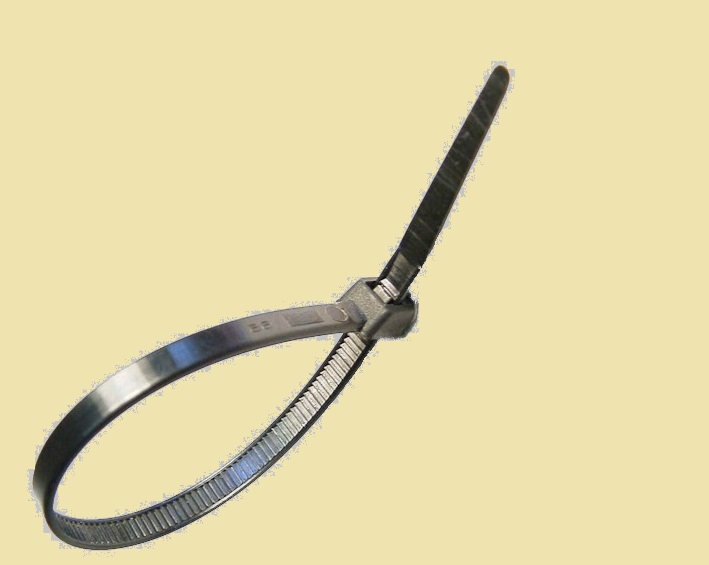Cable tie

|
A cable tie is a long, thin strap made from nylon or stainless steel, which can be pulled into a loop and tightened to hold together cables, wires and other objects. It is a very simple design that is extremely effective, easy to use and very versatile.
Available in a wide range of lengths and thicknesses, cable ties usually have a pointed end which – once the tie is wrapped wound the items to be tied together – inserts into a gate at the other end. When pulled through the gate by the desired amount, the gate teeth lock into the serrations on the tape allowing numerous tightening positions.
Typical lengths for cable ties include:
- 110mm x 2.5mm
- 185mm x 4.8mm
- 300mm x 4.8mm
- 370mm x 7.6mm
Other lengths and widths are available according to the manufacturer.
Cable ties can be used for a myriad of tying applications which include:
- Securing car hose pipes.
- Keeping wires secured unobtrusively to steelwork.
- A host of gardening applications.
Cable ties can generally be released by cutting the strap, but pushing a release button (on some varieties) or inserting a tool such as a screwdriver between the teeth and the gate.
[edit] Related articles on Designing Buildings
- Adhesives.
- Clamp.
- Construction equipment.
- Construction tools.
- Cramp.
- Crimp.
- Fixings.
- Fixtures.
- Ground anchor.
- Industrial fasteners market.
- Rivet.
- Soil nailing.
- Staples.
- Strap.
- The history of nails.
- Timber.
- Types of bolts.
- Types of fixings.
- Types of nails.
- Types of nuts.
- Types of screws.
- Types of washer.
- Welding.
Featured articles and news
The UK's Modern Industrial Strategy: A 10 year plan
Previous consultation criticism, current key elements and general support with some persisting reservations.
Building Safety Regulator reforms
New roles, new staff and a new fast track service pave the way for a single construction regulator.
Architectural Technologist CPDs and Communications
CIAT CPD… and how you can do it!
Cooling centres and cool spaces
Managing extreme heat in cities by directing the public to places for heat stress relief and water sources.
Winter gardens: A brief history and warm variations
Extending the season with glass in different forms and terms.
Restoring Great Yarmouth's Winter Gardens
Transforming one of the least sustainable constructions imaginable.
Construction Skills Mission Board launch sector drive
Newly formed government and industry collaboration set strategy for recruiting an additional 100,000 construction workers a year.
New Architects Code comes into effect in September 2025
ARB Architects Code of Conduct and Practice available with ongoing consultation regarding guidance.
Welsh Skills Body (Medr) launches ambitious plan
The new skills body brings together funding and regulation of tertiary education and research for the devolved nation.
Paul Gandy FCIOB announced as next CIOB President
Former Tilbury Douglas CEO takes helm.
UK Infrastructure: A 10 Year Strategy. In brief with reactions
With the National Infrastructure and Service Transformation Authority (NISTA).
Ebenezer Howard: inventor of the garden city. Book review.
The Grenfell Tower fire, eight years on
A time to pause and reflect as Dubai tower block fire reported just before anniversary.
Airtightness Topic Guide BSRIA TG 27/2025
Explaining the basics of airtightness, what it is, why it's important, when it's required and how it's carried out.
Construction contract awards hit lowest point of 2025
Plummeting for second consecutive month, intensifying concerns for housing and infrastructure goals.
Understanding Mental Health in the Built Environment 2025
Examining the state of mental health in construction, shedding light on levels of stress, anxiety and depression.
The benefits of engaging with insulation manufacturers
When considering ground floor constructions.
Lighting Industry endorses Blueprint for Electrification
The Lighting Industry Association fully supports the ECA Blueprint as a timely, urgent call to action.























